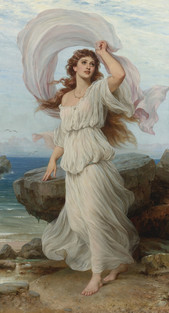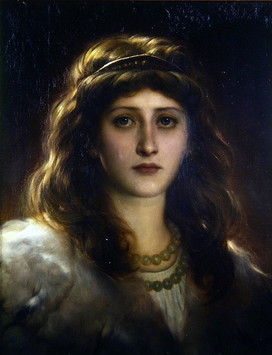Frank Dicksee - Gifted Gallery
- Lilium

- Jan 12, 2022
- 2 min read

Sir Francis Bernard Dicksee, born 27 November 1853, was an English Victorian painter and illustrator, best known for his pictures of dramatic literary, historical, and legendary scenes. He also was a noted painter of portraits of fashionable women, which helped to bring him success in his own time.
Dicksee's father, Thomas Dicksee, was a painter who taught Frank as well as his sister Margaret from a young age. The family lived in Fitzroy Square, Bloomsbury. Dicksee enrolled in the Royal Academy in 1870 where he was taught by Millais and Leighton and proved to be a model student achieving early success winning gold and silver medals. He also had a formative period assisting Henry Holiday with stained glass.
In the 1870s and 1880s much of Dicksee's creative effort was channeled into illustration, both for magazines the Cassell's, the Cornhill and the Graphic, and books, notably Longfellow's Evangeline (1882) and two editions of Shakespeare's plays (1883-92), all published by Cassell's. A number of these designs were later developed as easel paintings.

Dicksee began to exhibit at the R.A. in 1876. It was always his spiritual home, although he also supported the Grosvenor Gallery and other institutions. His name was made with Harmony, exhibited in 1877; a winning combination of sentimental theme, 'aesthetic' decor and academic technique, it was hailed as the 'picture of the year' and became one of the first works bought for the Chantrey Bequest.
Dicksee was elected A.R.A. in 1881 and R.A. ten years later. In addition to literary and historical subjects, he specialised in the relatively new genre of the psychodrama, examples being The Crisis (1891 ) and The Confession (1896). Many of his pictures were widely disseminated through engravings, and in 1900 he scored another great success with The Two Crowns, which again became a Chantrey purchase. However, the fashion for such costume pieces was waning, and increasingly he turned to portraiture and landscape. Never marrying, he settled in 1898 at 3 Greville Place in St John's Wood, an area then popular with academic artists.

In later years Dicksee received many honours, both at home and abroad. In 1921 Dicksee exhibited at the first exhibition of the Society of Graphic Art in London. The climax of his career was his election as President of the Royal Academy in 1924 in succession to Sir Aston Webb. He held the post with distinction and tact, and it brought him a knighthood in 1925 and a KCVO two years later. However, the advent of the Modern Movement, of which he was an outspoken critic, had left him an isolated figure.
Dicksee painted The Funeral of a Viking (1893; Manchester Art Gallery), which was donated in 1928 by Arthur Burton in memory of his mother to the Corporation of Manchester. Victorian critics gave it both positive and negative reviews, for its perfection as a showpiece and for its dramatic and somewhat staged setting, respectively.

Frank Dicksee died 17 October 1928, aged 74, in London. A book on Frank Dicksee's life and work with a full catalogue of his known paintings and drawings by Simon Toll was published by Antique Collector's Club in 2016.
Reading Recommendations & Content Considerations

Simon Toll










































































































































Comments